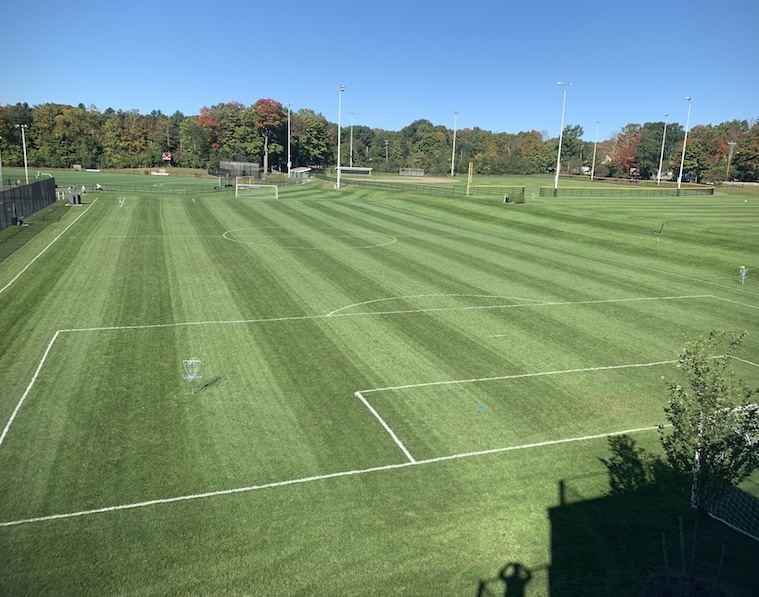By Ben Polimer
In this uncertain world, sports field managers need to be prepared for anything. We try to do this all the time, but now a new concept has come into play for many of us. Leaving our places of employment and staying home, and letting Mother Nature dictate rather than us.
I am a part of a group text chat that includes field managers from professional sports, municipalities (like myself) and vendors. We discuss many things, both turfgrass related and not, but the use of plant growth regulators (PGRs) came up. All facets of our industry should look to use these products. We need to think of PGRs as a tool in our toolbox.
Fields and facilities are not on TV at this time, so having turfgrass that’s “off color” or not its best quality is ok! We should not push our fields with extra fertilizer, especially with reduced staffing. I would suggest trying Prohexadione calcium (Anuew) because it does not have a “rebound” effect.
PGRs have been used on turfgrass for many years but only in the last 10-plus years have taken off in the sports field industry. This is mostly due to the price (trinexepac-ethyl (TE) patent ended only a few years ago, making off-patent product affordable). A gallon jug is inexpensive and will go a long way. I also think the fear of using these products has come down with the increased use.
PGRs are classified in two categories: Type I and Type II. Type I are foliar adsorbed – for example, Mefluidide (Embark). Type II are broken into two classes: Class A and Class B. Class A are foliar adsorbed and gibberellic acid is inhibited late in the process. Examples are trinexapac-ethyl (Primo) and Prohexadione calcium (Anuew). Class B products are root absorbed, and gibberellic acid is inhibited early in the process. Examples are Paclobutrazol (Trimmit) and Flurprimidol (Cutless). Most of my experiences are with Class A products, and I think sports field managers who are unfamiliar with the use of PGRs should use Class A products to start.
PGRs are great products, but they are never a substitute for good agronomics. PGRs should never be applied when turfgrass is stressed. Do not apply them to dormant turfgrass.
Using growing Degree Days (GDD) for PGR usage is a great way to predict timing for reapplication. For more information on using GDD, I recommend the University of Nebraska-Lincoln’s “Scheduling Plant Growth Regulator Applications” at http://turf.unl.edu/highlighted-research#regulator.
The benefits using PGRs in your program are different for every field manager and every facility, but benefits can include:
• Reduce clippings
• Enhance color, texture and density
• Extend life of painted lines
• Prevent tissue elongation
• Increase sod strength and divot resistance
• Better fall color and spring green up
• Wear tolerance and recuperative potential (rebound)
• Improved drought and heat stress tolerance
• Improved shade tolerance
• Increased root length and mass
(Source: Pamela Sherratt and Dr. John Street, SportsTurf magazine, February 2013.)
Most of my PGR usage has been with TE and on cool-season grasses (mainly on Kentucky bluegrass/ryegrass/Poa annua mix sports fields. I usually apply TE with a “cocktail” of other products such as insecticides, wetting agents and herbicides. When applying TE, expect a 50-percent growth reduction in three to five days after application. Discoloration will happen! It will dissipate, and then in subsequent applications the turfgrass is used to the application and will, in turn, be darker.
If you use growth covers, flooring, or other types of coverings on turfgrass, you can use TE to “pre-condition” the turfgrass. Reduce the growth while under the cover and time the “rebound” when the covering comes up.
A PSU study concluded that a sand-based rootzone can have reduced divot size by 10 to 20 percent. In a native soil field, the divot size can be reduced by 10 percent.
TE applications early in the spring and late in the fall can help with better spring green up and better fall color. I have done applications late in the summer, it seems to hold color longer on those cool nights of the fall. With my application restrictions in Massachusetts, I have not done a fall application.
Using the “rebound” effect, the regrowth of the turfgrass plant coming out of suppression, can be the field manager’s best friend. My fields are not used in the summer, and we apply PGRs in summer to reduce mowing. I time the last application to help “grow out” damage from fall soccer.
PGRs can also be used to extend the life of paint lines. I recommend halving the rate of the label of TE and mixing it with your bulk paint. Paint with PGR can be used every three to four weeks and will help keep lines. It can reduce the need for restringing during off-play periods.
Other advantages with using PGRs include reduced turfgrass decline from both tree and stadium shade. This makes sense when reducing vertical growth. There have been mixed findings on increased root length and mass on cool-season turfgrass (Sherratt and Street). Bermudagrass has shown an increased root length and mass.
Maybe using a PGR will help you and your facility through this uncertain time. Many facilities are facing layoffs, reduced workforce, and staggered shifts. If you have the ability to use a PGR, this might be the time to try it.
Ben Polimer is fields and grounds coordinator, Town of Weston, Mass., and is president of the New England Sports Turf Managers Association.
[Editor’s Note: Ben Polimer has spoken on the topic of PGRs at the Sports Turf Managers Association Conference, and has written on the topic. The content seen here is Polimer’s update of his 2017 article on the topic of PGRs.]
For archived audio of Polimer’s STMA Conference presentation on the topic of PGRs, visit https://sportsfieldmanagementonline.com/podcast/
For our Route to Recovery Zoom video interview with Ben Polimer, visit https://sportsfieldmanagementonline.com/2020/05/06/route-to-recovery-interview-with-ben-polimer-video/11459/

